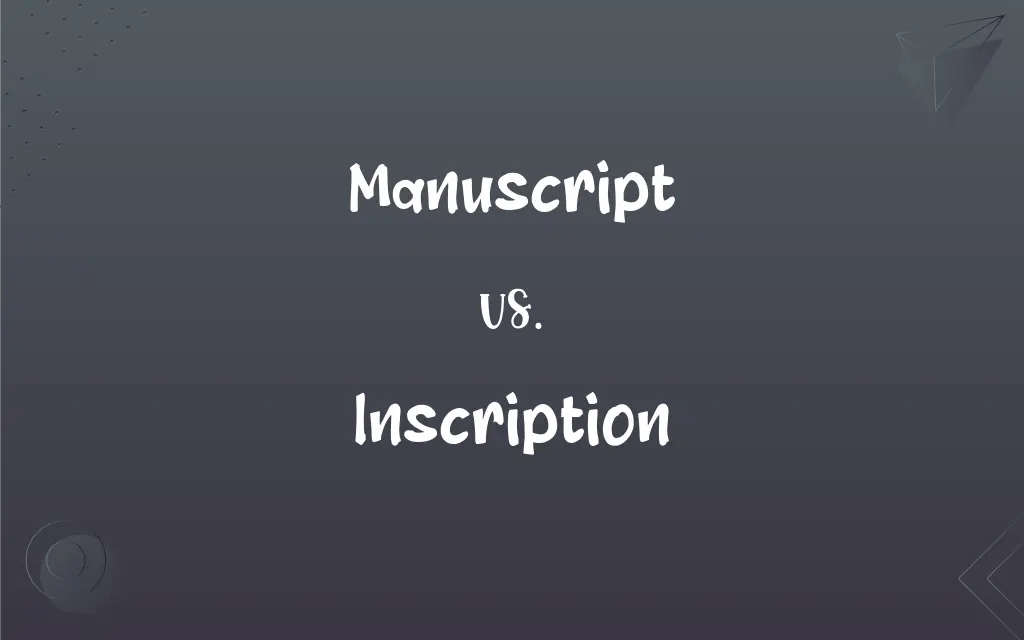Manuscript vs. Inscription: What's the Difference?
Edited by Janet White || By Harlon Moss || Updated on October 13, 2023
A manuscript is a handwritten or typed document, while an inscription is a brief dedication or message written on an object.

Key Differences
A manuscript pertains to a handwritten or typed composition, usually of considerable length or importance. Conversely, an inscription refers to a brief dedication, note, or message that's carved, engraved, or otherwise written on a material like stone, metal, or paper.
Manuscripts often encompass works of literature, science, or art. They can be drafts, final copies, or any other forms of detailed documents. Inscriptions, on the other hand, are concise, containing only essential information, perhaps a dedication, a date, or an owner's name.
The history of manuscripts goes back centuries, often relating to the creation of books, scholarly papers, or official documents. They have been critical to the dissemination of knowledge. Inscriptions have an equally ancient history, but they usually serve as markers or provide brief insights, often seen on monuments, coins, or personal belongings.
Manuscripts are generally preserved for their content, and they can be found in libraries, archives, or personal collections. Inscriptions, because they are often on objects, are preserved both for the content of the writing and for the object itself, which might be displayed in museums or held as personal mementos.
The medium of manuscripts is typically paper, although ancient ones might be on parchment or vellum. Inscriptions are found on a broader range of materials, including wood, metal, stone, and even bones.
ADVERTISEMENT
Comparison Chart
Definition
A handwritten or typed document.
A brief dedication or message on an object.
Length
Typically lengthy.
Concise.
Medium
Mostly on paper, parchment, or vellum.
Varied: stone, metal, paper, wood, etc.
Preservation
For content; in libraries or archives.
For content & object; in museums or personal.
Historical Context
Related to books, documents, or knowledge.
Found on monuments, coins, belongings.
ADVERTISEMENT
Manuscript and Inscription Definitions
Manuscript
A document written by hand.
The museum displayed a medieval manuscript of a famous novel.
Inscription
A dedication written in a book or engraved on an item.
The inscription in the book read, To my dearest friend.
Manuscript
A typed or handwritten version of a book, article, or composition.
She submitted her manuscript to various publishing houses.
Inscription
A phrase that signifies ownership or origin.
The painting had a small inscription indicating the artist's name.
Manuscript
An author's original copy of their work.
The manuscript had notes scribbled in the margins, showing the author's thought process.
Inscription
Words carved on stone or metal to commemorate an event.
The inscription on the monument detailed the battle's significance.
Manuscript
A piece of music written or printed in notation.
The conductor examined the manuscript for the evening's performance.
Inscription
Words written or engraved on a surface.
The inscription on the tombstone was weathered but still legible.
Manuscript
An ancient or historical document.
The newly discovered manuscript shed light on the civilization's customs.
Inscription
A short, formal note or phrase.
The ring had an inscription of their wedding date.
Manuscript
A handwritten book, poem, or other document, or a collection of such handwritten documents bound together
The contents of the manuscript include a romance and a saint's life.
Inscription
The act or an instance of inscribing.
Manuscript
A version of a book, article, or other work before being published or prepared for publication
The author submitted the manuscript as a text file.
Inscription
A marking, such as the wording on a coin, medal, monument, or seal, that is inscribed.
FAQs
Where are manuscripts typically found?
Manuscripts are often found in libraries, archives, or personal collections.
Can inscriptions be found in books?
Yes, inscriptions can be dedications or notes written inside books.
Is a manuscript always handwritten?
No, manuscripts can be both handwritten or typed.
What is the importance of inscriptions on historical objects?
Inscriptions provide context, dates, or insights into the object's origin or significance.
Are all manuscripts old?
No, while many are historical, new manuscripts are created whenever authors write or type their works.
Can a manuscript be considered an ancient artifact?
Yes, ancient or historical manuscripts are often considered artifacts.
Do manuscripts always pertain to books?
No, manuscripts can also relate to scholarly papers, articles, or other compositions.
Are inscriptions limited to texts?
Mainly, but inscriptions can also include symbols or signs with specific meanings.
What's an example of an ancient inscription?
Ancient Roman coins often had inscriptions indicating the reigning emperor.
What is a manuscript?
A manuscript is a handwritten or typed document, often of significant length or importance.
What is the main purpose of an inscription?
An inscription serves to convey a brief message, dedication, or information on an object.
Can an inscription be erased?
It depends on the material; for example, inscriptions on stone are more permanent than those on paper.
How does one differentiate between manuscript and inscription on paper?
Manuscripts are longer compositions, while inscriptions are brief notes or dedications.
Why are inscriptions important for archaeologists?
They offer valuable insights into the language, culture, and events of ancient societies.
How has the digital age impacted manuscripts?
Digital tools have made it easier to write, store, and share manuscripts, but they've also shifted the
Are manuscripts and inscriptions similar in length?
Typically, manuscripts are lengthier, while inscriptions are concise.
Can a book be both a manuscript and have an inscription?
Yes, a book can be a manuscript, and it can also contain an inscription, like a dedication.
Can a manuscript be a draft?
Yes, manuscripts can be drafts, final copies, or any form of a document.
What materials are commonly used for inscriptions?
Inscriptions are commonly found on materials like stone, metal, wood, and paper.
How are manuscripts preserved?
They're usually kept in controlled environments in libraries or archives.
About Author
Written by
Harlon MossHarlon is a seasoned quality moderator and accomplished content writer for Difference Wiki. An alumnus of the prestigious University of California, he earned his degree in Computer Science. Leveraging his academic background, Harlon brings a meticulous and informed perspective to his work, ensuring content accuracy and excellence.
Edited by
Janet WhiteJanet White has been an esteemed writer and blogger for Difference Wiki. Holding a Master's degree in Science and Medical Journalism from the prestigious Boston University, she has consistently demonstrated her expertise and passion for her field. When she's not immersed in her work, Janet relishes her time exercising, delving into a good book, and cherishing moments with friends and family.































































